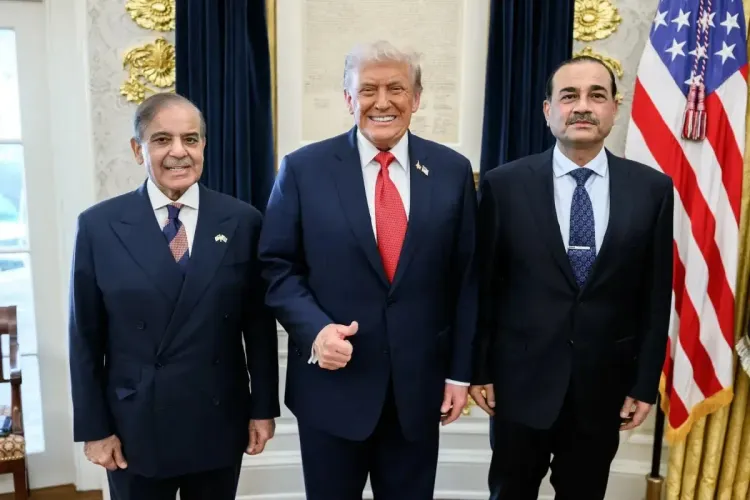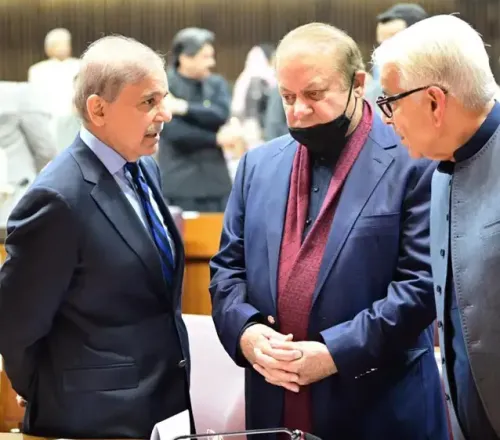Could Pakistan's New Missile Deal Disturb Peace in South Asia?

Synopsis
Key Takeaways
- The US has added Pakistan to its list of AIM-120 AMRAAM missile buyers.
- This deal raises concerns about destabilizing the balance of power in South Asia.
- Pakistan's military modernization may provoke a regional arms race.
- Historical patterns suggest US arms transfers to Pakistan could lead to long-term instability.
- Peace in South Asia can only be achieved through dialogue and cooperation.
Washington: In a significant development that may alter the delicate power dynamics in South Asia, the United States has included Pakistan among the purchasers of the AIM-120 Advanced Medium-Range Air-to-Air Missile (AMRAAM). This adjustment to a pre-existing US arms agreement with Raytheon transcends a mere defence deal — it indicates a potential rearmament of Pakistan's air capabilities amidst an already volatile security landscape.
The involvement of Pakistan in this programme, which exceeds $2.5 billion, rekindles a defence alliance that had largely stagnated due to years of tense relations with Washington. For Pakistan, whose air force remains heavily dependent on its fleet of American F-16 fighter jets, the addition of these cutting-edge BVR (beyond-visual-range) missiles signifies a substantial technological leap. However, from a regional perspective, it sparks alarming concerns regarding stability, deterrence, and the potential for escalation among nuclear-armed adversaries.
The AMRAAM, capable of striking targets at ranges exceeding 150 kilometres, delivers precision, velocity, and a "fire-and-forget" feature that lets pilots disengage immediately after launch. While technically impressive, such a system has profound strategic consequences in Pakistan's context.
Pakistan's military has historically aimed for parity with India, despite facing significant economic challenges and ongoing domestic turmoil. The country's track record of aggressive posturing, coupled with the military's excessive sway over foreign policy, renders the AMRAAM agreement far more consequential than a routine upgrade. This seemingly innocuous arms deal could substantially shift the regional deterrence balance.
The airspace in South Asia has always been sensitive; technological advancements on one side compel countermeasures from the other.
After India showcased its indigenous Astra BVR missile system, it highlighted its growing self-sufficiency and ability to safeguard its airspace. In response, Pakistan has opted to seek external sources to sustain parity instead of embracing domestic innovation. Thus, the AMRAAM deal signifies a continuation of dependency — and a readiness on Washington's part to overlook the destabilizing effects of supplying a military whose strategic ambitions have frequently jeopardized peace.
This renewed US-Pakistan relationship also rekindles lingering concerns about the nature of their security partnership.
Historically, American arms transfers to Pakistan have been rationalized on the grounds of counterterrorism or defence collaboration, only for those armaments to subsequently be wielded against India. The F-16 fleet, originally supplied under similar pretenses, became a pivotal component of Pakistan's conventional deterrent against its eastern counterpart. The reintegration of the AMRAAM into this scenario risks fostering the same conduct — a renewed confidence in coercive diplomacy bolstered by advanced weaponry.
The timing of this arrangement is particularly alarming. Pakistan is grappling with one of the most severe economic crises in its history, coupled with a turbulent political atmosphere and a military struggling to maintain internal security. Instead of prioritizing domestic reform and stability, the nation's leadership appears focused on modernizing its military capabilities. This reflects a misalignment of priorities — a familiar pattern for observers of Pakistan's civil-military dynamics, where the pursuit of military parity often overshadows social and economic imperatives. From a regional security standpoint, this missile deal could inject uncertainty back into South Asia's deterrence landscape.
India and Pakistan have engaged in multiple conflicts, endured countless border clashes, and nearly escalated tensions following the Balakot air strikes in 2019, during which Pakistan’s F-16s, equipped with earlier AMRAAM versions, were already involved. The introduction of more advanced missile variants, including the C8 and D3, only heightens the potential lethality of future confrontations.
Critics of the deal within policy circles contend that the US risks repeating historical errors. For decades, American backing for Pakistan's military has yielded short-term tactical cooperation but long-term instability. Each wave of arms assistance has bolstered the military's power domestically, often at the expense of democratic governance. It also empowers the military to act as an independent power center — wielding foreign policy and national security decisions without civilian oversight.
By rearming Pakistan under the pretense of modernization, Washington may inadvertently strengthen an institution that has historically destabilized both its own society and the larger region. For India, this development emphasizes the persistent asymmetry in US policy concerning South Asia.
While Washington labels New Delhi as a "strategic partner", the ongoing military aid to Pakistan introduces contradictions into that narrative. It complicates India's strategic calculus, necessitating a diversion of resources to counter Pakistan's enhanced air capabilities even as it attends to its maritime and northern borders. In attempting to maintain influence over both South Asian powers, the US risks playing both sides — a balancing act that history has shown to be unsustainable.
Beyond the India-Pakistan dynamic, the overarching concern lies in the precedent this sets. If Pakistan's acquisition of advanced missiles is perceived as a reward for engaging with Washington, it may prompt other regional players to pursue similar arrangements to preserve balance. This could accelerate an arms race in one of the world's most militarized areas. At a time when global powers advocate restraint and dialogue in conflict-prone regions, the decision to amplify missile sales in South Asia sends an opposing message.
There’s also the matter of technology security. Pakistan's history of safeguarding advanced military systems has faced scrutiny, raising concerns over unauthorized access and proliferation. Given the nation's past of nuclear proliferation through networks associated with A Q Khan, Western analysts have repeatedly urged caution in transferring sensitive defense technologies. The AMRAAM deal, despite its conventional nature, rekindles those anxieties — especially as Pakistan continues to forge military alliances with China and Turkey.
If history serves as a guide, such arms transfers seldom yield stability. Instead, they cultivate new dependencies and embolden military adventurism. Pakistan's leadership has routinely exploited its geostrategic position to secure Western military support, only to later pursue policies counter to US interests. Whether during the Cold War, the Afghan jihad, or the post-9/11 epoch, the pattern remains consistent: tactical alignment followed by strategic divergence. The AMRAAM deal threatens to perpetuate that cycle under the guise of "modernization".
The ultimate casualty of this arrangement could be peace itself. South Asia remains a nuclear flashpoint, with a lengthy history of crises triggered by miscalculations. In such a context, the infusion of more advanced air-to-air missiles does not bolster deterrence — it compresses decision times and escalates the risks of confrontation. Each side, perceiving the other as emboldened, reacts with increased vigilance and countermeasures. In that light, the AMRAAM sale is not merely an arms transaction; it serves as a strategic signal that could unravel years of cautious restraint.
Washington’s rationale may be to maintain leverage in Islamabad, but the potential cost could be steep. By bolstering the Pakistani military’s capabilities at a moment of internal fragility, the US risks empowering a security apparatus that has historically prioritized confrontation over cooperation. The world has witnessed how easily tactical superiority in weaponry can morph into strategic recklessness — and in a region where two nuclear-armed countries share a contested border, that is a gamble no one can afford.
Ultimately, the AMRAAM deal signifies a lost opportunity. Instead of motivating Pakistan to invest in stability, reform, and regional confidence-building, it perpetuates outdated patterns of militarization. For a nation that has yet to resolve its internal political divisions or economic vulnerabilities, the pursuit of cutting-edge missiles is not a sign of strength but of misplaced priorities.
As South Asia teeters on the brink of renewed strife, the international community must recognize that peace cannot be founded on firepower. Genuine stability will only emerge when nations are discouraged from pursuing weapons superiority and are encouraged to engage in transparency, restraint, and dialogue. The AMRAAM sale to Pakistan achieves the opposite — it arms a precarious region and emboldens the very forces that thrive on instability. And in doing so, it jeopardizes South Asia’s status as one of the most perilous arenas of contemporary geopolitics.










